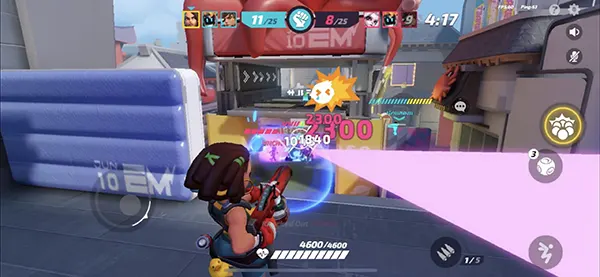T3 Arena has steadily gained traction among mobile gamers since its release, positioning itself as a fast-paced, hero-based shooter tailored specifically for smartphones. With Overwatch struggling to maintain momentum on console and PC, a legitimate mobile alternative is a highly anticipated prospect. But does T3 Arena truly live up to that expectation, or is it just another imitation of a well-known title? Let’s explore the gameplay mechanics, hero system, user experience, and monetisation model to find out.
Core Gameplay: Quick Matches and Fluid Controls
At its core, T3 Arena offers short, intense matches that typically last no more than five minutes, making it ideal for mobile users who want action-packed gaming sessions without a time commitment. Its 3v3 format promotes strategic teamwork while maintaining a casual-friendly environment.
The control scheme has been finely tuned for mobile play. With smooth joystick movement and intuitive aiming, players can jump into a match with minimal learning curve. The auto-fire function, which can be toggled off, helps beginners ease into the gameplay without being overwhelmed.
In contrast to Overwatch’s expansive maps and complex objectives, T3 Arena simplifies its core structure. Modes like Team Deathmatch, Control, and Payload Escort are concise and fast-paced. This design choice caters well to smartphone screens and on-the-go gaming habits.
Hero Design and Customisation
T3 Arena boasts a growing roster of over 30 unique characters, each with distinct weapons, abilities, and ultimate skills. The heroes aren’t direct copies of Overwatch characters, though some archetypes feel familiar. For example, Labula’s area control abilities echo elements of Zenyatta’s gameplay without being a clone.
What makes the game interesting is the progression system. As you play, you unlock hero upgrades and cosmetics, encouraging continuous engagement. Each character can be enhanced through levelling, though these upgrades are largely balanced for fair play across tiers.
Visually, the hero designs lean toward a stylised, colourful aesthetic rather than realism. This approach ensures better performance on a wide range of smartphones and appeals to a broader audience, including younger players.
Player Experience and Accessibility
One of T3 Arena’s strongest points is how accessible it is. The game loads quickly, matches are easy to find, and the tutorials are comprehensive. This makes it a great entry point for players new to hero shooters. There’s no requirement for an external controller, and the UI has been clearly optimised for touchscreens.
Voice chat and team ping systems are built in, which is a rarity for mobile shooters. These features enhance the competitive experience, allowing teams to coordinate without the need for third-party apps.
Latency is a non-issue in most regions, thanks to well-maintained global servers. Players report stable framerates even on mid-tier devices, making the experience seamless. It’s evident that the developers have prioritised performance alongside content.
Comparison to Overwatch’s Accessibility
Unlike Overwatch, which often requires precise coordination and fast reflexes on large maps, T3 Arena is designed with mobile ergonomics in mind. Its controls are simplified without compromising too much on tactical depth.
Another advantage lies in the matchmaking. Overwatch’s ranked queues can sometimes exceed five minutes, while T3 Arena consistently delivers matches in under 30 seconds — a significant benefit for mobile gamers who want instant action.
Also notable is the entry barrier. T3 Arena doesn’t require account syncing with external clients or lengthy updates before play. It’s ready almost immediately after installation, which is a huge plus for casual gamers.

Monetisation and Community Feedback
T3 Arena is free to download, with monetisation based on optional purchases such as battle passes, skins, and character unlocks. While there are gacha elements in acquiring some heroes, the core gameplay remains fair and competitive even without spending.
The community response to monetisation has been largely positive. Unlike many mobile shooters, T3 Arena avoids pay-to-win mechanics. Cosmetic upgrades are the main incentive for purchases, and matchmaking is performance-based rather than gear-based.
Moreover, the developers are active on social channels, frequently updating the game and responding to user feedback. Seasonal events, limited-time modes, and regular patches ensure that the gameplay remains fresh without being reliant on aggressive marketing tactics.
Long-Term Value and Sustainability
For those seeking a long-term multiplayer title, T3 Arena offers enough depth to keep users engaged over months. Hero balancing, seasonal content, and new map introductions demonstrate the studio’s commitment to longevity.
The game also fosters a growing esports scene, albeit in its early stages. Tournaments and ranked competitions are already appearing in select regions, which hints at its potential for broader competitive play.
In 2025, as mobile gaming continues to dominate the entertainment landscape, T3 Arena stands out as a meaningful alternative to Overwatch — not just a copycat. It’s a purpose-built shooter that respects the limitations and strengths of mobile devices.